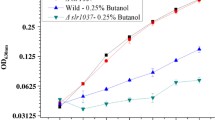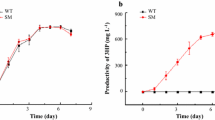Abstract
Butanol is highly toxic to cyanobacterial cells, which could restrict the future application of this renewable system in producing carbon neutral biofuel butanol. To seek knowledge regarding butanol tolerance in cyanobacteria, a library of response regulator (RR) gene mutants of Synechocystis sp. PCC 6803 was screened. The results showed that the deletion mutant of an orphan RR-encoding genes ll0039 was more sensitive to butanol than the wild type, while complementation of the ∆slr1037 mutant with the sll0039 gene recovered its tolerance to the same level as the wild type, suggesting that the sll0039 gene was involved in the regulation of tolerance against butanol. Further analysis employing an integrated liquid chromatography-mass spectrometry (LC-MS)-based and gas chromatography-mass spectrometry (GC-MS)-based metabolomics was conducted to determine the possible regulatory network of butanol tolerance mediated by Sll0039. LC-MS analysis allowed the identification of several metabolites, such as adenosine 5′-diphosphate (ADP)-glucose, dihydroxyacetone phosphate (DHAP), d-ribose 5-phosphate (R5P), d-glucose 6-phosphate (G6P), d-fructose 6-phosphate (F6P), α-ketoglutaric acid (AKG), uridine 5′-diphospho (UDP)-glucose, and nicotinamide adenine dinucleotide phosphate (NADP), which were differentially regulated between the wild type and the ∆sll0039 mutant grown under butanol stress, while GC-MS analysis identified 1, 2, and 2 metabolic modules associated with the sll0039 gene deletion at 24, 48, and 72 h, respectively, suggesting that they were under control directly or indirectly by Sll0039 RR. In addition, a metabolomic comparison of the metabolic responses to butanol stress was conducted in the ∆sll0039 mutant and the ∆slr1037 mutant previously found to be involved in butanol tolerance (Chen et al. Biotechnol Biofuels 7:89 2014a), and the results showed that the regulatory networks mediated by Sll0039 and Slr1037 could be functionally independent in Synechocystis. The results provided a metabolomic description of the butanol tolerance network regulated by Sll0039.






Similar content being viewed by others
References
Alper H, Stephanopoulos G (2007) Global transcription machinery engineering: a new approach for improving cellular phenotype. Metab Eng 9(3):258–267
Alper H, Moxley J, Nevoigt E, Fink GR, Stephanopoulos G (2006) Engineering yeast transcription machinery for improved ethanol tolerance and production. Science 314(5805):1565–1568
Alsaker KV, Spitzer TR, Papoutsakis ET (2004) Transcriptional analysis of spo0A overexpression in Clostridium acetobutylicum and its effect on the cell’s response to butanol stress. J Bacteriol 186(7):1959–1971
Anfelt J, Hallstrom B, Nielsen J, Uhlen M, Hudson EP (2013) Using transcriptomics to improve butanol tolerance. Appl Environ Microbiol 79:7419–7427
Ashby MK, Houmard J (2006) Cyanobacterial two-component proteins: structure, diversity, distribution, and evolution. Microbiol Mol Biol Rev MMBR 70(2):472–509
Ball SG, Morell MK (2003) From bacterial glycogen to starch: understanding the biogenesis of the plant starch granule. Annu Rev Plant Biol 54:207–233
Bennette NB, Eng JF, Dismukes GC (2011) An LC-MS-based chemical and analytical method for targeted metabolite quantification in the model cyanobacterium Synechococcus sp. PCC 7002. Anal Chem 83(10):3808–3816
Brynildsen MP, Liao JC (2009) An integrated network approach identifies the isobutanol response network of Escherichia coli. Mol Syst Biol 5:277
Camsund D, Lindblad P (2014) Engineered transcriptional systems for cyanobacterial biotechnology. Front Bioeng Biotechnol 2:40
Chen L, Wu L, Wang J, Zhang W (2014a) Butanol tolerance regulated by a two-component response regulator Slr1037 in photosynthetic Synechocystis sp. PCC 6803. Biotechnol Biofuels 7:89
Chen L, Zhu Y, Song Z, Wang J, Zhang W (2014b) An orphan response regulator Sll0649 involved in cadmium tolerance and metal homeostasis in photosynthetic Synechocystis sp. PCC 6803. J Proteomics 103:87–102
DiLeo MV, Strahan GD, den Bakker M, Hoekenga OA (2011) Weighted correlation network analysis (WGCNA) applied to the tomato fruit metabolome. PLoS One 6(10):e26683
Dunlop MJ (2011) Engineering microbes for tolerance to next-generation biofuels. Biotechnol Biofuels 4:32
Durre P (2007) Biobutanol: an attractive biofuel. Biotechnol J 2(12):1525–1534
Durre P (2008) Fermentative butanol production: bulk chemical and biofuel. Ann N Y Acad Sci 1125:353–362
Fiehn O (2002) Metabolomics—the link between genotypes and phenotypes. Plant Mol Biol 48:155–171
Green EM (2011) Fermentative production of butanol—the industrial perspective. Curr Opin Biotechnol 22(3):337–343
Grundel M, Scheunemann R, Lockau W, Zilliges Y (2012) Impaired glycogen synthesis causes metabolic overflow reactions and affects stress responses in the cyanobacterium Synechocystis sp. PCC 6803. Microbiology 158(Pt 12):3032–3043
Hemamalini R, Khare S (2014) A proteomic approach to understand the role of the outer membrane porins in the organic solvent-tolerance of Pseudomonas aeruginosa PseA. PLoS One 9(8):e103788
Hoch JA (2000) Two-component and phosphorelay signal transduction. Curr Opin Microbiol 3(2):165–170
Huang HH, Camsund D, Lindblad P, Heidorn T (2010) Design and characterization of molecular tools for a synthetic biology approach towards developing cyanobacterial biotechnology. Nucleic Acids Res 38(8):2577–2593
Jin H, Chen L, Wang J, Zhang W (2014) Engineering biofuel tolerance in non-native producing microorganisms. Biotechnol Adv 32(2):541–548
Jozefczuk S, Klie S, Catchpole G, Szymanski J, Cuadros-Inostroza A, Steinhauser D, Selbig J, Willmitzer L (2010) Metabolomic and transcriptomic stress response of Escherichia coli. Mol Syst Biol 6:364
Kaczmarzyk D, Anfelt J, Sarnegrim A, Hudson EP (2014) Overexpression of sigma factor SigB improves temperature and butanol tolerance of Synechocystis sp. PCC6803. J Biotechnol 182–183:54–60
Kim WY, Kang S, Kim BC, Oh J, Cho S, Bhak J, Choi JS (2008) SynechoNET: integrated protein-protein interaction database of a model cyanobacterium Synechocystis sp. PCC 6803. BMC Bioinformatics 9(Suppl 1):S20
Klahn S, Hagemann M (2011) Compatible solute biosynthesis in cyanobacteria. Environ Microbiol 13(3):551–562
Lan EI, Liao JC (2011) Metabolic engineering of cyanobacteria for 1-butanol production from carbon dioxide. Metab Eng 13(4):353–363
Lan EI, Liao JC (2012) ATP drives direct photosynthetic production of 1-butanol in cyanobacteria. Proc Natl Acad Sci U S A 109(16):6018–6023
Langfelder P, Horvath S (2008) WGCNA: an R package for weighted correlation network analysis. BMC Bioinformatics 9:559
Ledauphin J, Le Milbeau C, Barillier D, Hennequin D (2010) Differences in the volatile compositions of French labeled brandies (Armagnac, Calvados, Cognac, and Mirabelle) using GC-MS and PLS-DA. J Agric Food Chem 58(13):7782–7793
Lee SY, Park JH, Jang SH, Nielsen LK, Kim J, Jung KS (2008) Fermentative butanol production by Clostridia. Biotechnol Bioeng 101(2):209–228
Liu J, Chen L, Wang J, Qiao J, Zhang W (2012) Proteomic analysis reveals resistance mechanism against biofuel hexane in Synechocystis sp. PCC 6803. Biotechnol Biofuels 5(1):68
Liu ZX, Li HC, Wei YP, Chu WY, Chong YL, Long XH, Liu ZP, Qin S, Shao HB (2013) Signal transduction pathways in Synechocystis sp. PCC 6803 and biotechnological implications under abiotic stress. Crit Rev Biotechnol. doi:10.3109/07388551.2013.838662
Liu D, Chen Y, Ding FY, Zhao T, Wu JL, Guo T, Ren HF, Li BB, Niu HQ, Cao Z, Lin XQ, Xie JJ, He XJ, Ying HJ (2014) Biobutanol production in a Clostridium acetobutylicum biofilm reactor integrated with simultaneous product recovery by adsorption. Biotechnol Biofuels 7(1):5
Los DA, Zorina A, Sinetova M, Kryazhov S, Mironov K, Zinchenko VV (2010) Stress sensors and signal transducers in cyanobacteria. Sensors 10(3):2386–2415
Ma R, Zhang Y, Hong H, Lu W, Lin M, Chen M, Zhang W (2011) Improved osmotic tolerance and ethanol production of ethanologenic Escherichia coli by IrrE, a global regulator of radiation-resistance of Deinococcus radiodurans. Curr Microbiol 62(2):659–664
Maeda K, Narikawa R, Ikeuchi M (2014) CugP is a novel ubiquitous non-GalU-type bacterial UDP-glucose pyrophosphorylase found in cyanobacteria. J Bacteriol 196(13):2348–2354
Miranda H, Cheregi O, Netotea S, Hvidsten TR, Moritz T, Funk C (2013) Co-expression analysis, proteomic and metabolomic study on the impact of a Deg/HtrA protease triple mutant in Synechocystis sp. PCC 6803 exposed to temperature and high light stress. J Proteomics 78:294–311
Nicolaou SA, Gaida SM, Papoutsakis ET (2010) A comparative view of metabolite and substrate stress and tolerance in microbial bioprocessing: from biofuels and chemicals, to biocatalysis and bioremediation. Metab Eng 12(4):307–331
Pal D, Khozin-Goldberg I, Didi-Cohen S, Solovchenko A, Batushansky A, Kaye Y, Sikron N, Samani T, Fait A, Boussiba S (2013) Growth, lipid production and metabolic adjustments in the euryhaline eustigmatophyte Nannochloropsis oceanica CCALA 804 in response to osmotic downshift. Appl Microbiol Biotechnol 97(18):8291–8306
Pollak N, Dolle C, Ziegler M (2007) The power to reduce: pyridine nucleotides—small molecules with a multitude of functions. Biochem J J402(2):205–218
Qiao J, Wang J, Chen L, Tian X, Huang S, Ren X, Zhang W (2012) Quantitative iTRAQ LC-MS/MS proteomics reveals metabolic responses to biofuel ethanol in cyanobacterial Synechocystis sp. PCC 6803. J Proteome Res 11(11):5286–5300
Ren Q, Shi M, Chen L, Wang J, Zhang W (2014) Integrated proteomic and metabolomic characterization of a novel two-component response regulator Slr 1909 involved in acid tolerance in Synechocystis sp. PCC 6803. J Proteomics 109C:76–89
Roessner U, Luedemann A, Brust D, Fiehn O, Linke T, Willmitzer L, Fernie A (2001) Metabolic profiling allows comprehensive phenotyping of genetically or environmentally modified plant systems. Plant Cell 13(1):11–29
Rutherford BJ, Dahl RH, Price RE, Szmidt HL, Benke PI, Mukhopadhyay A, Keasling JD (2010) Functional genomic study of exogenous n-butanol stress in Escherichia coli. Appl Environ Microbiol 76(6):1935–1945
Schiel-Bengelsdorf B, Montoya J, Linder S, Durre P (2013) Butanol fermentation. Environ Technol 34(13–16):1691–1710
Schwarz D, Orf I, Kopka J, Hagemann M (2013) Recent applications of metabolomics toward cyanobacteria. Metabolites 3(1):72–100
Strøm AR, Kaasen I (1993) Trehalose metabolism in Escherichia coli stress protection and stress regulation of gene expression. Mol Microbiol 8(2):205–210
Su Y, Wang J, Shi M, Niu X, Yu X, Gao L, Zhang X, Chen L, Zhang W (2014) Metabolomic and network analysis of astaxanthin-producing Haematococcus pluvialis under various stress conditions. Bioresour Technol 170:522–529
Swan TM, Watson K (1999) Stress tolerance in a yeast lipid mutant: membrane lipids influence tolerance to heat and ethanol independently of heat shock proteins and trehalose. Can J Microbiol 45(6):472–479
Tian X, Chen L, Wang J, Qiao J, Zhang W (2013) Quantitative proteomics reveals dynamic responses of Synechocystis sp. PCC 6803 to next-generation biofuel butanol. J Proteomics 78:326–345
Tomas CA, Welker NE, Papoutsakis ET (2003) Overexpression of groESL in Clostridium acetobutylicum results in increased solvent production and tolerance, prolonged metabolism, and changes in the cell’s transcriptional program. Appl Environ Microbiol 69(8):4951–4965
Van Dijck P, Colavizza D, Smet P, Thevelein JM (1995) Differential importance of trehalose in stress resistance in fermenting and nonfermenting Saccharomyces cerevisiae cells. Appl Environ Microbiol 61(1):109–115
Wang HL, Postier BL, Burnap RL (2002) Optimization of fusion PCR for in vitro construction of gene knockout fragments. BioTechniques 33(1):26–32
Wang J, Chen L, Tian X, Gao L, Niu X, Shi M, Zhang W (2013) Global metabolomic and network analysis of Escherichia coli responses to exogenous biofuels. J Proteome Res 12(11):5302–5312
Wang J, Zhang X, Shi M, Gao L, Niu X, Te R, Chen L, Zhang W (2014a) Metabolomic analysis of the salt-sensitive mutants reveals changes in amino acid and fatty acid composition important to long-term salt stress in Synechocystis sp. PCC 6803. Funct Integr Genom 14(2):431–440
Wang Y, Shi M, Niu X, Zhang X, Gao L, Chen L, Wang J, Zhang W (2014b) Metabolomic basis of laboratory evolution of butanol tolerance in photosynthetic Synechocystis sp. PCC 6803. Microb Cell Factories 13(1):151
Yoshihara S, Suzuki F, Fujita H, Geng XX, Ikeuchi M (2000) Novel putative photoreceptor and regulatory genes required for the positive phototactic movement of the unicellular motile cyanobacterium Synechocystis sp. PCC 6803. Plant Cell Physiol 41(12):1299–1304
Zhang B, Horvath S (2005) A general framework for weighted gene co-expression network analysis. Stat Appl Genet Mol Biol 4:Article17
Zhu H, Ren X, Wang J, Song Z, Shi M, Qiao J, Tian X, Liu J, Chen L, Zhang W (2013) Integrated OMICS guided engineering of biofuel butanol-tolerance in photosynthetic Synechocystis sp. PCC 6803. Biotechnol Biofuels 6(1):106
Acknowledgments
The research was supported by grants from the National Basic Research Program of China (“973” program, project no. 2011CBA00803, no. 2014CB745101, and no. 2012CB721101), the National High-tech R&D Program (“863” program, project no. 2012AA02A707), and the National Science Foundation of China (NSFC, project no. 31470217).
Author information
Authors and Affiliations
Corresponding authors
Electronic supplementary material
Below is the link to the electronic supplementary material.
ESM 1
(PDF 1679 kb)
Rights and permissions
About this article
Cite this article
Niu, X., Zhu, Y., Pei, G. et al. Elucidating butanol tolerance mediated by a response regulator Sll0039 in Synechocystis sp. PCC 6803 using a metabolomic approach. Appl Microbiol Biotechnol 99, 1845–1857 (2015). https://doi.org/10.1007/s00253-015-6374-y
Received:
Revised:
Accepted:
Published:
Issue Date:
DOI: https://doi.org/10.1007/s00253-015-6374-y




